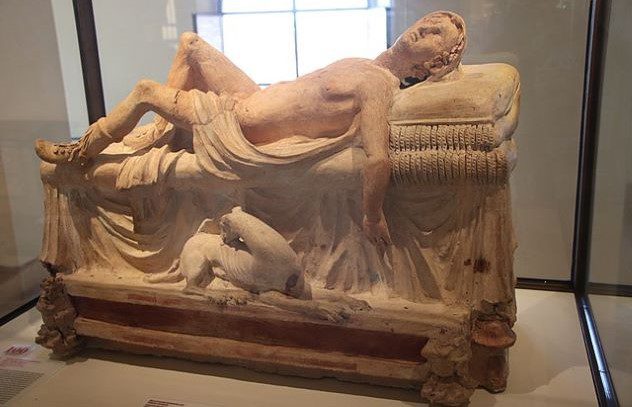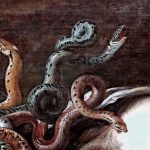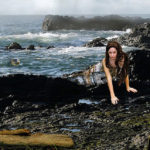 Mysteries
Mysteries  Mysteries
Mysteries  History
History 10 Surprising Stories About the Texas Rangers
 Humans
Humans 10 Philosophers Who Were Driven Mad by Their Own Theories
 Miscellaneous
Miscellaneous 10 Video-Game-Worthy Weapons and Armors from History
 Weird Stuff
Weird Stuff 10 Psychics Who Accurately Predicted Wartime Events
 The Arts
The Arts 10 Pieces of Art Inspired by a Broken Heart
 Health
Health 10 Science Fiction-Sounding New Medical Treatments
 History
History 10 Surprising Facts About the Father of Submarine Warfare
 Space
Space Ten Astonishing New Insights into Alien Worlds
 Weird Stuff
Weird Stuff 10 Bizarre Summer Solstice Rituals Still Practiced Today
 Mysteries
Mysteries Top 10 Haunting Facts About the Ghost Ship MV Alta
 History
History 10 Surprising Stories About the Texas Rangers
 Humans
Humans 10 Philosophers Who Were Driven Mad by Their Own Theories
Who's Behind Listverse?

Jamie Frater
Head Editor
Jamie founded Listverse due to an insatiable desire to share fascinating, obscure, and bizarre facts. He has been a guest speaker on numerous national radio and television stations and is a five time published author.
More About Us Miscellaneous
Miscellaneous 10 Video-Game-Worthy Weapons and Armors from History
 Weird Stuff
Weird Stuff 10 Psychics Who Accurately Predicted Wartime Events
 The Arts
The Arts 10 Pieces of Art Inspired by a Broken Heart
 Health
Health 10 Science Fiction-Sounding New Medical Treatments
 History
History 10 Surprising Facts About the Father of Submarine Warfare
 Space
Space Ten Astonishing New Insights into Alien Worlds
 Weird Stuff
Weird Stuff 10 Bizarre Summer Solstice Rituals Still Practiced Today
10 Amazing Artworks from The Mysterious Etruscans
The Etruscans were once the dominant civilization in northern Italy. In the middle of the first century BC they ruled from the feet of the Alps down into Campania. Rome was just another town in their sphere of influence. Around 500 BC, however, the balance of power began to tip in Rome’s favor.
By 27 BC, they were fully integrated into the Roman world. The Etruscan language died out, and their writing remains hard to decipher. What we know of the Etruscans comes from Roman and Greek writers and the masterpieces of artistic work that they have left behind.
Here are ten artworks that offer tantalizing glimpses into the Etruscan world.
Related: Ten Bizarre Discoveries about Ancient Civilizations and Our Ancestors
10 Apollo of Veii
Etruscan religion is a complex topic of research for historians. Most of our knowledge comes from Roman sources and the occasional artifact bearing the name of a deity. The richness of Etruscan archaeology, however, gives clues to the magnificence of their temples. At the Sanctuary of Minerva in the ancient town of Veii, remains of the terracotta decorations of religious sites have been found. These feature a complex roof design and fragments of life-size depictions of the gods.
The best preserved of these idols is the Apollo of Veii. It once stood on the roof beams atop pillars that were nearly 40 feet (12 meters) tall. The statue dates from around 500 BC and is influenced by the Greek styles of art that permeated the Mediterranean. But it is also distinctly Etruscan. Etruscan sculptures often show figures with an enigmatic, potentially creepy smile. Apollo appears to smirk as he strides forward. Originally, this statue seems to have been facing one of Hercules, and the two were contesting over the body of a deer.
Like most ancient statues, the Apollo of Veii was painted in vivid colors that can still be seen today. An Etruscan temple would have been a riot of vivid hues.[1]
9 Mars of Todi
The Etruscans were renowned for their work in bronze. This was recognized by the Romans. When they sacked the Etruscan town of Velzna in 265 BC, the Romans carried off over 2000 bronze statues. Etruscan sites are littered with small bronze votive statues that were dedicated to their gods. The somewhat misnamed Mars of Todi is one of the most spectacular.
This statue does not show the Roman god Mars but instead is a stunningly detailed model of a soldier, probably made in the late 5th century BC. It was discovered buried under slabs of rock and may have been buried ritually by its donors. The soldier is shown wearing typical armor and would once have been resting with a spear in his hand. The helmet is missing, but it is otherwise perfect.
On one of the finely worked plates of the soldier’s breastplate is a small inscription written in the Umbrian language but using the Etruscan alphabet. It tells us that this statue was made for someone called Ahal Trutitis. Whether he was giving thanks for surviving a battle or in hopes of surviving his next is not known.[2]
8 Dying Adonis

The Etruscans seem to have had a strong belief in life after death. Much of their art that has survived comes in the form of decorated tombs and sarcophagi. In the Vatican Museum is an Etruscan funerary monument crafted from painted terracotta that is topped with a depiction of Adonis in his final moments.
Dating from the third century BC, this work shows Adonis sprawled on a bed with a bleeding wound on his left thigh. According to Greek myth, Adonis, who was loved by Aphrodite, was injured by a wild boar while hunting. When he bled to death in Aphrodite’s arms, the goddess caused anemone flowers to bloom wherever his blood had been shed.
Adonis appearing on an Etruscan tomb shows how they integrated myths and legends from other cultures. But it also hints at how they interpreted them. Adonis was deeply mourned by his divine lover, perhaps as the occupier of this tomb was by his loved ones, but also lived on as a flower. The Etruscans, too, may have hoped for a second life after death.[3]
7 Sarcophagus of Seianti Hanunia Tlesnasa
Most people today go into their tombs in relatively unadorned coffins. For the Etruscans, at least those who could afford it, their tombs were much more personalized and unique. Many sarcophagi that housed the Etruscan dead have been uncovered and show their occupants in life-like positions—often as if they were taking part in a feast.
One of the best preserved is that of an Etruscan woman of the 2nd century BC named Seianti Hanunia Tlesnasa. The terracotta sarcophagus shows her reclining on one elbow and lifting a veil from her head. She has dressed in her best for death. Obviously, a wealthy lady, she is clothed in a fine tunic and mantle, and her head is topped with a tiara.
How do we know that the woman in the sculpture represents Seianti Hanunia Tlesnasa? Inside the sarcophagus, a skull was found and used to create a reconstruction of the living woman. There is little doubt that Seianti Hanunia Tlesnasa was the model for the sculpture—though the artist was somewhat flattering.[4]
6 Sarcophagus of the Spouses
Anthropoid, human-shaped sarcophagi give us our best look at Etruscan life. We can even see relationships. Etruscan tombs were often used to bury many members of the same family, but some sarcophagi show more than one person. One of the best Etruscan sarcophagi shows a happily married couple.
The Sarcophagus of the Spouses dates from the 6th century BC and depicts a man and wife lying on a dining couch as if in the middle of a banquet. It is constructed from four large pieces of terracotta and would once have been highly painted. The man and woman are shown with happy expressions and at the peak of their physical health. Their hair is intricately braided, and they gesture with their hands as if caught in mid-conversation.
There is a very similar sarcophagus in the Louvre, which may have been made in the same workshop as the one in Rome. The similarity of features on the people depicted suggests that this sarcophagus was meant to represent a generalized happy couple rather than the individuals buried inside.[5]
5 Tomb of the Leopards
Many Etruscans were buried in large communal burial sites known as necropolises—cities of the dead. Some of these contain complex tombs that were cut from the rock and decorated to make fitting homes for the deceased.
The Tomb of the Leopards is named for a painting of two leopards that face each other near the ceiling of the tomb. Below them, there are images of people enjoying a banquet. A woman and a man share each of the dining couches. The diners wear wreaths and are surrounded by food, musicians, and dancing.
The meaning of this banquet scene is controversial. Was this a representation of the Etruscan afterlife? We have seen how Etruscan sarcophagi showed the dead in similar positions. Or was this the representation of a meal that would be held in honor of the dead?
Not all tomb paintings are as sedate as this banquet. One tomb, known as the Tomb of Whipping, shows a man whipping a lady as she bends forward to fellate another man.[6]
4 Monteleone Chariot
It is rare for a chariot from the ancient world to survive in anything like its original state. However, the Monteleone chariot, dating from 530 BC, is one of the best preserved in the world and shows the artistic capabilities of the Etruscans.
The chariot owes its survival to having been buried in a tomb and remaining undisturbed until the owner of the land accidentally broke into the grave. It was then dismantled and sold to the Metropolitan Museum of New York. The chariot would once have been made of wood with thin sheets of decorated bronze covering it. These show the hero Achilles being given armor by his divine mother, Thetis. Alongside the bronze, there were inlays of ivory, amber, and glass.
Close examination of the chariot shows that at some point before it was buried, it had been in a serious accident. It was then repaired to be included in the burial. The Etruscans were generous to their dead—but apparently not that generous to warrant a new chariot.[7]
3 Etruscan Jewelery
The Etruscans profited in many ways from a vast trading network that brought in not only wealth but also imported goods and skilled craft workers from other civilizations. Many of these influences can be seen in the jewelry that the Etruscans wore. Most was made in high-purity gold that was decorated with complex designs. Many pieces of gold show motifs derived from Greek legends but Egyptian scarabs can also be found.
The Vulci set of jewelry housed in the Metropolitan Museum was discovered in an Etruscan grave dating from the 5th century BC. There are ten pieces of jewelry in all, and they are made mostly of gold. They include a large necklace with eleven glass pendants, two earrings with rock crystal, and a series of broaches. The rings have carved stones showing gods, heads, and a youth with a sword.
Etruscan jewelers would sometimes use exotic materials in their designs. Amber, which could be carved into delicate forms, would have been imported all the way from the Baltic Sea in the north.[8]
2 Etruscan Gold Book
The Etruscans did not stay in northern Italy. Artifacts from the Etruscans have been found around the Mediterranean and up into the Black Sea area. It is likely that some of these were carried by Etruscan traders and may even have accompanied Etruscan settlers looking for new homes. That may explain how one of the world’s most extraordinary books ended up in Bulgaria.
The “book”—some scholars would dispute it meets the definition of a book—is formed from six sheets of gold that were bound together by two rings. The sheets contain many strange images of a mermaid, priests, a horse rider, and harps. Around the images are Etruscan inscriptions. What do these golden plates mean?
Other examples of golden plates found in tombs across the Greek world contain texts related to the cult of Orphism. This belief offered a way for the dead to live forever in the afterlife by teaching them magical spells and instructions. Precisely what the Etruscan text says remains to be seen.
The translation of Etruscan has been helped by a further series of golden plates from Pyrgi that contains a bilingual text written in both Etruscan and Phoenician. These texts seem to relate to a religious event but are also important for showing how cosmopolitan the Etruscans were in their dealings with other cultures.[9]
1 Chimera of Arezzo
The Capitoline Wolf is one of the most famous statues in Rome. It shows a female wolf with large breasts. Underneath the beast, two small boys, the founders of Rome, Romulus and Remus, are suckling. While it seems to be the perfect symbol of ancient Rome, it is not. The figures of the children were added in the Renaissance, and the wolf herself is probably Etruscan in origin—though some researchers think it dates from the 11th century AD.
There is one animal sculpture that is undoubtedly Etruscan, and it is considered to be the greatest expression of their artistry that survives. The Chimera of Arezzo dates from around 400 BC and was rediscovered in 1553 with other Etruscan votive offerings. The chimera was a terrifying beast from Greek mythology, with the head and body of a lion, the head of a goat sprouting from its back, and a biting viper for a tail. According to legend, the monster was killed by the hero Bellerophon, riding on the winged horse Pegasus. There was probably a bronze statue of Bellerophon that accompanied the chimera.
The discovery of this work sparked renewed interest in the Etruscans. The famed sculptor Benvenuto Cellini recorded how, when it was discovered, the Duke of Tuscany, Cosimo de Medici, spent hours delicately cleaning it with small tools and took the symbol of the chimera as his own.[10]








